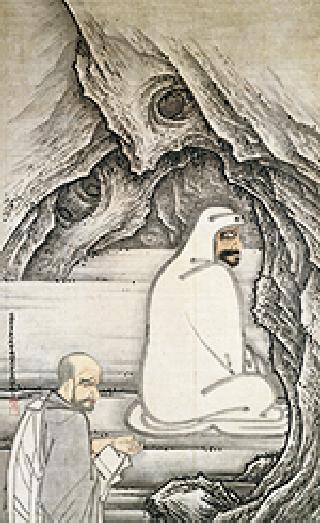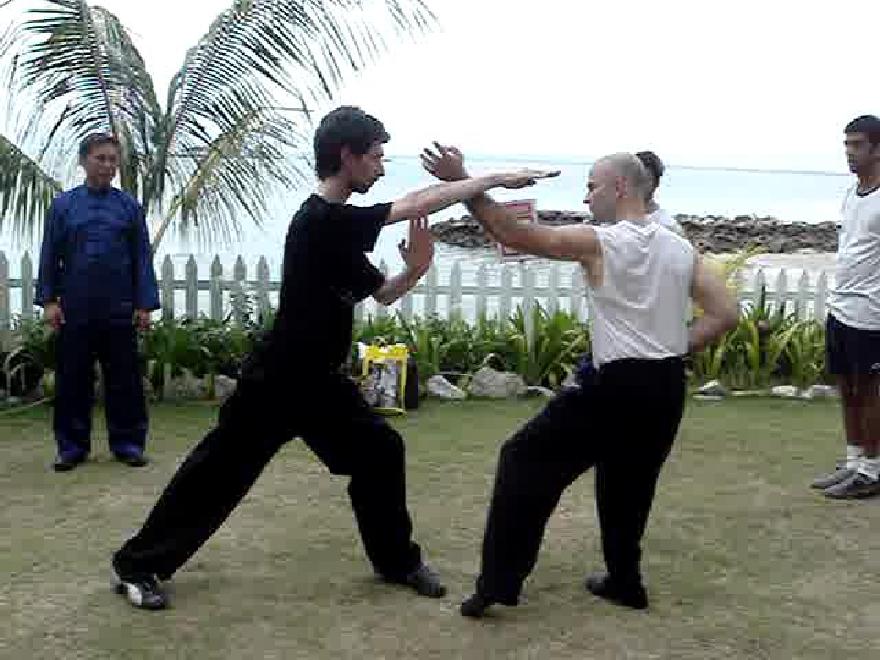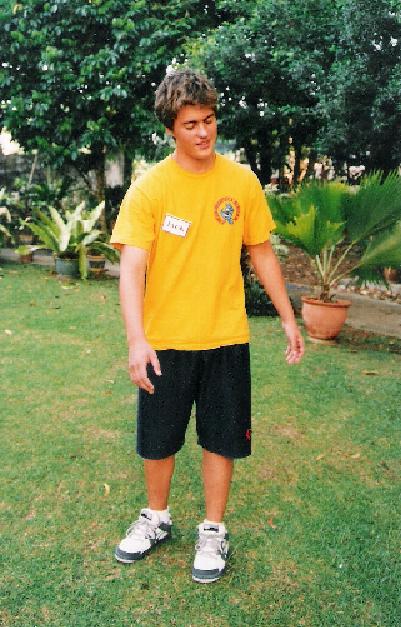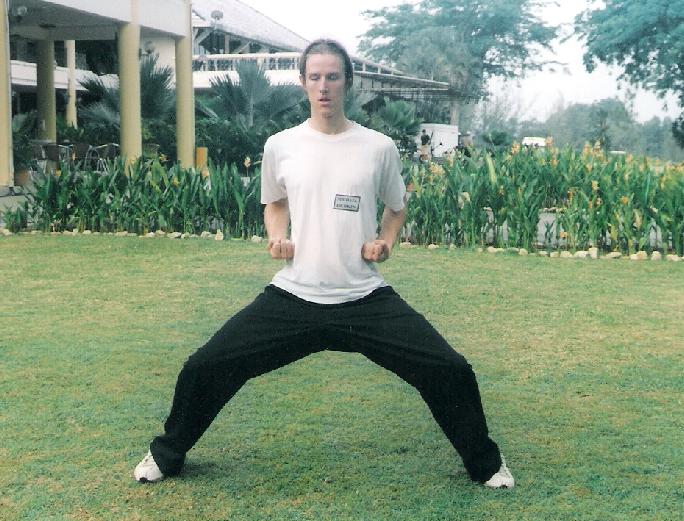September 2009 (Part 1)
SELECTION OF QUESTIONS AND ANSWERS

Hui Ke, the Second Patriarch, offerring an arm to Bodhidharma, the First Patriarch - a national treasure of the Tokyo National Museum, reproduced from http://www.tnm.jp/en/servlet/Con?pageId=B01&processId=01&event_id=5315
Question 1
I have great respect for you and all real kung fu artists in the world. It is a pity but I have no real kung fu teachers in my country, that's why I cannot learn kung fu.
— Gasham, Azerbaijan
Answer
Thank you for your e-mail and kind words.
It is indeed a great pity that not only kungfu but martial arts in general have been debased to such an extent that martial artists today do not have a good reputation. Even some martial art masters are not good role models. They are often aggressive and stressful. The image of a true martial artist as a gentle and kind person but highly combat efficient is rare nowadays. However, we in Shaolin Wahnam aspire to this ideal.
It is true that the type of kungfu we practice is quite different from what most other kungfu practitioners practice. But if you wish to practice and benefit from what we teach, a good way is to learn some basic kungfu forms from a local kungfu instructor or even from my books, and then attend my Intensive Shaolin Kungfu Course.
After the course you have to practice diligently on your own. You can keep contact with us through our Virtual Kwoon, and attend other courses given by me or our certified Shaolin Wahnam instructors.
In this way you could attain a reasonable good standard of kungfu in two or three years. You will achieve what most other kungfu practitioners may not achieve at all even if they train for a long time, such as developing internal force, having mental clarity, being able to use your kungfu patterns for combat, and most important of all living a rewarding, meaningful life.
Question 2
Why do you or you senior students or other real warriors not participate in such competitions as MMA or UFC? As an example to demonstrate that kung fu is a great art as Sifu Sung Lu Tang or Sifu Hoa Yun Jia did in the beginning of 20th century it will be great.
Answer
There are a few good reasons why we in Shaolin Wahnam do not take part in competitions like Mixed Martial Art (MMA) and Ultimate Fighting Championship (UFC) competitions. I believe that other genuine kungfu masters share these reasons too, which also reflect the philosophy of traditional kungfu masters in the past. These reasons can be summed up in the expression that we "walk our talk" or practice what we say.
The main aim of our kungfu training, whether in our Shaolin Kungfu or Wahnam Taijiquan, is for personal cultivation in all its physical, emotional, mental and spiritual aspect. Our cultivation gives us good health, vitality, longevity, mental clarity, spiritual joys as well as combat efficiency. These benefits enable us to make our life and the lives of other people meaningful and rewarding.
As it was also the case with kungfu practitioners in the past, it has never been our objectives to win competitions, or to show others how good a fighter we are. We do not glamorize fighting, and try to avoid it as best as we can. But if we have to fight, we will certainly fight well.
Then why do we train a martial art if we hope not to be engaged in real fighting at all? Would we also achieve those wonderful benefits mentioned above, except combat efficient, by training high-level chi kung instead of Shaolin Kungfor or Wahnam Taijiquan.
Actually our chi kung is derived from our Shaolin Kungfu. In the past, high-level chi kung was known as "nei kung" or internal art. It was taught to specially selected disciples after they had spent many years in kungfu training and had proven themselves to be of high moral character.
One may still enjoy the wonderful benefits of good health, vitality, longevity, mental clarity and spiritual joys by practicing high-level chi kung without any martial aspects, but it is the martial training that brings the attainment to an exceptionally high level. A few examples will make this clear.
To most people the concept of good health means being free from illness and enjoying general well-being. This marks the apex of non-martial chi kung training. But to a true martial artist, this is only the beginning. His concept of good health will include many aspects ordinary people do not even dream about, like being able to spar for an hour or two without feeling tired or panting for breaths.
To most people the concept of mental clarity means being able to think clearly. But it is much more to a true martial artist. His mental clarity is trained to such an exceptionally high level that during combat, for example, he can analyze a few possible responses in a given combat situation and in a split second make the best choice. In a non-combat situation, when he enters a room full of people he can sense who are friendly to him and who are antagonistic, even when some of them are behind his back!
Another important reason why we do not want to take part in competitions of MMA, UFC and the like is that we neither want to be seriously hurt by our opponents nor to seriously hurt our opponents. There is no doubt that competitors in MMA, UFC and the like are top-class fighters. A single strike by these top-class fighters can maim or kill. We also have no doubt that we can also maim or kill with just one strike.
We have a choice. We can choose to put ourselves in such a situation where we can be badly hurt or hurt others badly, or we can choose not to be in such a situation at all. We have sufficient mental clarity to choose wisely. We are not misled by fame or price money to make a bad choice. We also do not have any need nor interest to show others that kungfu can be used for fighting. If others do not believe kungfu is combat efficient, that is their problem, not ours.

The Shaolin Kungfu we practiced is quite different from what is practiced by many other Shaolin practitioners today. For example, while many others bounce about in their sparring, we use traditional forms.
Question 3
I understand that if we look at this question as Chan adepts it will seem to be very funny.
Answer
Chan, or Zen as it is more popularly known, originated from the Shaolin Temple. The first three Zen Patriarchs -- Bodhidharma, Hui Ke, Seng Can -- stayed and taught at the Shaolin Temple in Henan Province. The Fourth Patriarch, Dao Xin, moved to the Dongshan Temple in Hubei Province where the Fifth Partrarch, Hong Jen also taught.
The famous Sixth Patriarch, Hui Neng, moved south and taught in numerous temples, like Da Fan Temple, Guo En Temple, Nan Hua Temple and Bao Lin Temple, but periodically returned to the Shaolin Temple which he considered the source of Zen. Hence, Shaolin Kungfu and Chan or Zen are intimately related.
Some people may wonder what has Shaolin Kungfu, a martial art, to do with Zen, a spiriitual cultivation. Shaolin Kungfu developed as a direct result of Zen. When Bodhidharma taught Zen at the Shaolin Temple, he found the Shaolin monks weak -- physically, emotionally, mentally and spiritually. So he taught them two sets of chi kung exercises, Eighteen Lohan Hands and Sinew Metamorphosis, to strengthen them so that they could attain Enlightenment more effectively. Eighteen Lohan Hands later developed into Shaolin Kungfu.
Practicing genuine, traditional Shaolin Kungfu not only contributes to spiritual cultivation, it is spiritual culticvation itself. When we practice Shaolin Kungfu, we are practicing Zen itself. Many of us in Shaolin Wahnam have more and deeper spiritual experiences while practicing Shaolin Kungfu than when practicing Zen meditation.
Question 4
I would like to first thank you for your generous information on the Shaolin Arts, including Cosmos Chi Kung.
— Andrew, USA
Answer
Disseminating genuine information on Shaolin Kungfu, Cosmos Chi Kung and Taijiquan is an important aim of our school as part of our effort to preserve these wonderful arts for posterity. The information is derived from the teachings of past masters which we have tired and confirmed from our own experience to be true and beneficial.
A lot of the information contains secrets which past masters kept only for their selected disciples. Indeed many people have expressed surprise as well as gratitude for our generosity in revealing these secrets. We have to reveal these secrets, otherwise we cannot preserve the arts.
We are also aware that in disseminating genuine information, we may sometimes offend certain people, but we choose to state the truth rather than hide behind pleasantries. For example, we say that Shaolin Kungfu and Taijiquan can be used for combat, practicing chi kung can overcome so-called incurable diseases, and internal force is real. These are the teachings passed down by past masters, and we have practiced them ourselves and found them to be true.
Other people, including masters, may think otherwise. Many Shaolin and Taijiquan practitioners think that Shaolin and Taijiquan patterns are not combat effective and they prefer Kick-Boxing instead; some people think that chi kung cannot cure diseases, and that internal force is a myth. That is their business, and we have no interest to convince them. But for those who trust us and need our help, even if they are not our students, we give our advice and help generously.

Jack from Scotland enjoying "Flowing Breeze Swaying Willow" during an Intensive Chi Kung Course
Question 5
These past few months I have been practicing the Chi Kung Art "Lifting the Sky" and the Stance Training Art "Horse Stance". I have started notice a lot of things, mainly that I have been getting a lot of "good luck" in general.
Answer
Congratulations for your good results, including getting a lot of good luck. Many people, including chi kung practitioners, do not know that besides good health, vitality and longevity, chi kung also gives us good luck.
The Chinese term for good luck is "hao yun qi", which word-by-word means "good circulation of chi". The Chinese in the past discovered that if one had good circulation of energy, he would have what we now call "good luck". Most Chinese today, may not realize this. If you ask a Chinese what "hao yun qi" means, he would answer that it is "good luck"; he wouldn't say it is "good circulation of chi".
This reminds me of a happy incident a few years ago. When I was in England, I visited my old school teacher, Miss Stamford Miss Stamford lives with her mother, who is over a 100 years old!. When she celebrated her 100th birthday, journalists asked her what the secret of her longevity was. She said it was because of good luck.
Marcus, the Chief Instructor of Shaolin Wahnam UK, was with me then. He commented that it was illuminating that this 100-year old woman, who was still fit to go for occasional morning walks in the woods said the secret of her living to more than a hundred years was "good circulation of chi".
Question 6
I've noticed I am repelling a lot of negative energy from people, as well as negative people and situations.
Answer
This is also another wonderful benefit of regularly practicing chi kung that is not generally known. Good chi attracts good chi, and bad chi attracts bad chi.
Hence when you practice chi kung, you generate good chi, which attracts good energy and good people, and repels bad energy and bad people. This is connected with why practicing chi kung also makes you lucky.

Sifu Michael of England enjoying the subtle joys of the Horse-Riding Stance
Question 7
In practicing the Horse Stance, my goal was to stay in the stance for 15 minutes in order to dramatically increase my internal force. I then thought that I was practicing wrongly, so I took a break from it. I am still doing "Lifting the Sky" 15-20 repetitions along with "Flowing Breeze Swaying Willows" afterwards, at least one time everyday.
I know that my stance is fairly correct. My state of mind within the stance is not good. I am relaxed only some of the time, and keep being time conscious instead of enjoying the stance.
Answer
Practicing "Lifting the Sky" followed by "Flowing Breeze and Swaying Willows" is excellent.
Regarding your stance training, you have identified your fault. Just correct it.
Being relaxed mentally is even more important than being relaxed physically. So, don't worry about the time, just relax both physically and mentally, and enjoy your training.
If you can stay at your stance for 15 minutes, that is very good. If you stay for only 5 minutes or even just 2 minutes, that is fine too, as long as you don't worry, don't intellectualize, and you enjoy your practice.
Question 8
Would it be cost effective to continue practicing the Horse Stance for at least 2-5 minutes (which is what I can do now) every day along with my regular practice? Would the amount of time matter for increasing internal force?
Answer
Yes, it is highly recommended that you continue your daily Horse Stance training for 2 or 3 minutes or whatever time you can remain at the stance in correct form and in a relaxed manner,
The time one can remain in the stance is an important contributing factor to increasing internal force. But there are also other important factors.
If he is in correct form and is relaxed, the longer he remains at the stance, the more internal force he will develop. But if his form is incorrect or he is tensed, or both, the longer he remains at the stance, not only he will not develop more internal force, he will also have more adverse effect.
Thus, remaining at the Horse Stance in correct form and in a relaxed manner for 5 minutes will derive more benefits, like more internal force and mental clarity, than remaining at the stance in incorrect form and in a tensed manner for 30 minutes.
Editorial Note Andrew's other questions and their answers will be posted in the next issue, September 2009 Part 2
LINKS
Selected Reading
- The Small Universe is Better than Pinching your Leg or Walking About
- Counters against the Shoot at the Initial, Medial and Final Stages of Attack
- What is Genuine, Traditional Taijiuan
- Supportive and Primary Attacks of Eagle Claws
- Shaolin Counters against Karate Attacks
